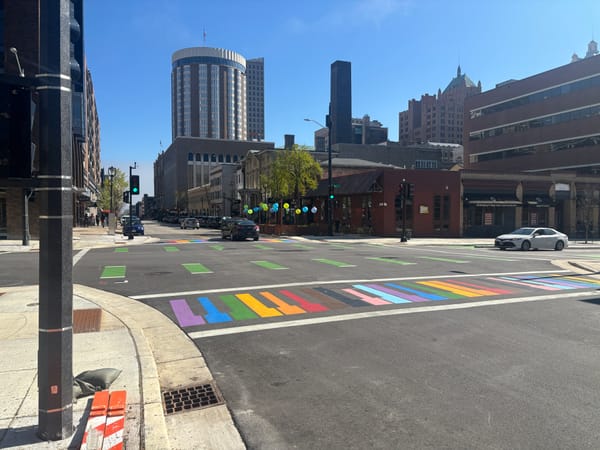Better Streets MKE, Vol. 15
Happy New Year! Isn't it a little late for that? Well, it's kind of rude of you to point that out, and in any case, there's more than one New Year. In the Jewish tradition, there's more than one new year. There is, of course, Rosh Hashanah, celebrated in the fall when we increment the year, but there is also the new year for animals, Rosh Hashanah Labehemah, celebrated in August, and Tu Bishvat, the new year of trees, which this year begins on January 24th. What I'm saying is there's many different new years and it's never the wrong time to reflect and look forward.
-A.B.
Also: we moved away from Substack to a self-hosted platform. Exuberant thanks to Mitchell for being extremely talented and making the migration happen. - M.M.
So, what changed in 2023 on Milwaukee streets, and what should we expect from 2024?
2023 saw a lot of changes to our streets
Milwaukee made impressive strides in physically changing the roadways to be safer for everyone. 2023 saw projects like Walnut Street’s transformation (notably, for a street whose Black life was all but destroyed to make way for highways); rapidly-implemented bike lanes on Lapham Boulevard; curb extensions across the city to reduce speeding and the “Milwaukee slide”; buffered bike lanes on Highland Boulevard; the city’s first protected intersection on Walnut and 6th; and the first case of advisory bike lanes in the city.
Friend of the newsletter Cade Gerlach has been tracking many of these projects on a map here.
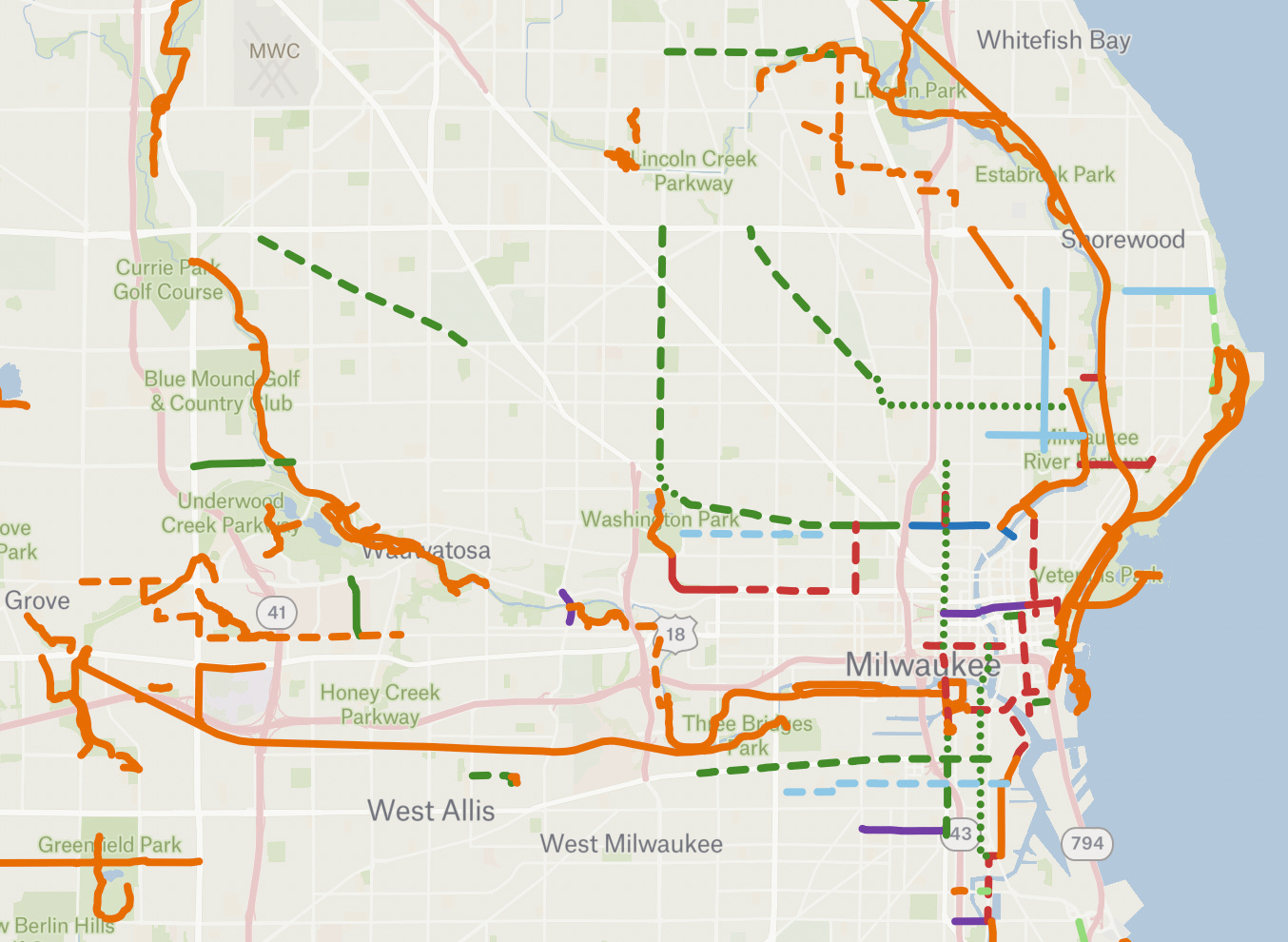
North Avenue’s well-intended, parking and planter-protected bike lane still has an outrageous amount of illegal parking as well as completely destroyed planters. Despite the East Side BID’s worthwhile investment, North Avenue has become a place to dodge not only cars but dangerous chunks of concrete from broken planters. We hope that the BID and DPW see this destruction for what it is: not innocent drivers “getting used” to a road change, but the insistence of some drivers that they are entitled to whatever space they want, and likely a great deal of impaired driving. Projects like next year’s transformation of Van Buren will need to not just cross our fingers and hope drivers get it right: they need good design, much better signage and marking, steel and concrete, and yes, enforcement and towing. Education and wayfinding is critical to give drivers a chance to get it right; too often our designs cheap out on that piece.
Transit changes and fiscal realities
2023 saw the first extension of the Hop; with that project complete, the City is now more competitive for grants for additional extensions. The County also implemented CONNECT1 (the first Bus Rapid Transit line), and is now in planning mode for the 27th Street North-South BRT line. Due to station and vehicle design, the Hop and the BRT are transit options that are more accessible for people with disabilities and mobility challenges than traditional buses. Thanks to the passing of the Milwaukee County sales tax, MCTS’s #SavetheBus campaign was successful. Many routes that would have been eliminated or faced serious cuts in frequency will continue to serve our region.
Still, transit did take a hit: the on-demand paratransit taxi program was ended. Riders with disabilities still have access to a van service, but this requires riders to schedule rides at least 24 hours in advance and is less reliable. The County stated that ending the taxi program was due to a rule from the Federal Transit Administration that mandated taxis to be wheelchair accessible and to have random drug tests for drivers. The City’s redesigns have not incorporated accessibility sufficiently either. For example, changes to roads like Lapham and Highland were great opportunities for installing accessible parking, but that has been missing; and wayfinding for people with mobility impairments around new road designs have been lacking as well.
Of course, the County continues to subsidize the driving of private cars. This subsidy is finally being openly discussed as County Parks leadership has committed to reducing its pavement maintenance obligation through projects like the conversion of parts of parkways into mixed use trails. Parks admits that paying for massive parking lots is an expensive task for a critically-underfunded agency. For example, Bradford Beach’s parking lot received a multi-million dollar investment, while people riding bikes to the beach via the Oak Leaf Trail must compete for space on very outdated and inadequate bike racks.
Changes at the state level
The state has also gotten in on the issue of reckless driving. Unfortunately, Wisconsin is not currently known as a bedrock of bipartisan action. Action on the issue has been minimal and mostly focused on harsher sentencing and fines, including the bill passed this year that also allows towing for unpaid “reckless driving” tickets. However, Governor Evers’ budget did include expanded access to driver’s education for low-income students. The state will also end the abysmal policy of not requiring a road test to get a license to drive multi-ton heavy machinery — you know, cars and trucks.
WisDOT’s freeways are potentially transformative projects. First, WisDOT has aggressively pushed the expansion of I-94, going so far as to hide the dirty truth that expansion will actually lead to more deaths. The agency attempted to promote the Orwellian speak of “fewer deaths per miles traveled”, rarely noting that their own projections show more deaths and injuries total. Unfortunately, WisDOT, like most state DOTs, views additional vehicle miles traveled as a boon. We’re thankful for the many advocates who have fought this expansion; their work has undoubtedly reduced its impact and won small favors for connectivity.
WisDOT has also been pushed to get a bit more creative regarding two other parts of its freeway system: 175 (the Stadium Freeway) and 794, a spur of highway that goes through downtown and turns what could be the most valuable piece of land in the entire state of Wisconsin into, quite literally, a bunch of sad empty parking lots. We’ll see what happens with these projects in 2024!
Deaths and injuries went down this year
In 2022, the City of Milwaukee’s Common Council unanimously adopted Vision Zero, which is a framework for achieving zero traffic deaths or serious injuries. The city set a goal to achieve this by 2037, which is ambitious but not impossible. (Milwaukee County has set a similar goal through its Complete Communities work, which will help the other municipalities in the county create their own safe streets plans.)
The data is pointing to good news compared to 2022. As of this publishing, 2023 has seen 73 deaths and 514 life-changing injuries due to traffic violence. In comparison, 2022 saw 87 deaths and 531 life-changing injuries.
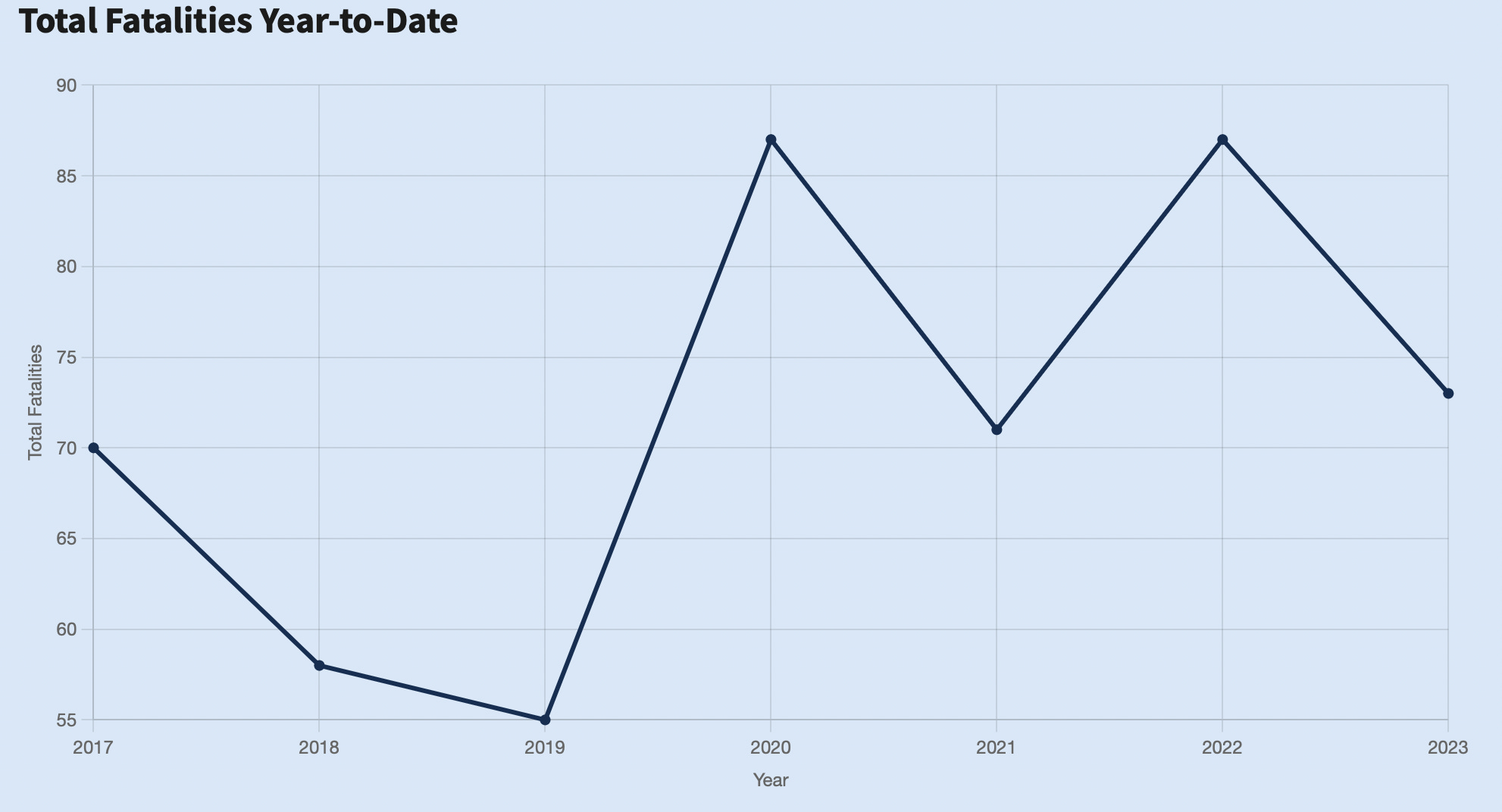
We can’t know for certain why we’re seeing these changes, but it’s likely a mix of good (like road redesigns) and the bad (risk avoidance, such as the 16% decline in walking, from Streetlight).
This year’s Crash Analysis report presented new High Injury Networks for drivers, pedestrians, and cyclists, as well as a combined map. We’re happy to see substantial data that is clearly impacting investment choices. We hope that the City will improve on sharing more of this data with the community so that neighbors can understand why changes are happening and how they benefit.
In 2024, look forward to more work from the Vision Zero office, with (hopefully) a Vision Zero plan to be presented to Common Council.
What we’d like to see in 2024
2024 will see new construction projects to keep enhancing our streets, as well as a ton of behind-the-scenes work for projects across the city that will break ground in 2025 and beyond. We won’t go into the full details of all of the projects to expect in 2024; for that, Cade’s map and Engage MKE are great resources.
There’s a lot to be excited about on the horizon. Here, we’ll highlight some of other things we’d like to see in 2024.
- WisDOT has a lot of projects coming up. State highways and interchanges as diverse as Fond Du Lac, Becher, 1st Street, Lisbon, Bluemound, Forest Home, and more will see projects in the next 4-5 years. That means that early design is happening now. What we want is simple: the National Avenue treatment, just about everywhere (with more transit prioritization and even better improvements for accessibility included).
- Improved accountability to Complete Streets policy. Milwaukee adopted a Complete Streets policy in 2018. We are finally seeing true CS road designs coming to fruition. However, the policy also requires maintaining access especially during construction. In 2024, we’d like to see more interest in the less-sexy but no less important issue of maintaining access and improving contractor standards, with consistency across the city. For example, pedestrian ramp access was maintained on portions of Water Street during this summer’s construction via temporary metal ramps, but construction on streets like 27th Street didn’t get the same treatment — forcing pedestrians in to the roadway or to turn around. It’s great to rebuild a shiny road. It’s also necessary to maintain safe and comfortable access on existing resources.
- Overhauling bike parking policy. Bike parking and storage is an underrated issue. For low-income people who depend on their bikes, theft is not just a minor inconvenience. Yet theft of a cheap bike is not something law enforcement takes seriously, since police generally determine severity of theft based on market value of the object, not the use value to its owner. Cheap bikes may not be worth insuring, even if riders were educated about insurance. Then there is the issue of cheap e-bikes, the batteries of which threaten aging housing stock that is already prone to fires. A lack of secure storage makes it difficult to frequently use a bike (especially a cargo and/or electric bike), even in parts of the city most amenable to riding. Large bike racks can also be used to daylight intersections, providing a double value. It’s time for the city to take seriously the need for a bike parking strategy beyond sporadic racks near businesses.
- Improved communications. Milwaukee is doing a lot with relatively little. Staff have their hands full with the many great projects we’re looking forward to. Unfortunately, this means relatively little time for communication to the broader public. We’d like to more communication about why projects are happening, with in-context, online, and in-person communication about the immediate benefits of that project within weeks of its completion. Communications helps to fend off potential backlashes to changes and to build a base of knowledge and support about future changes.
- Speed limit changes. A larger overhaul of the city’s speed limits was mostly removed from the city budget in favor of more money for things like speed humps. Still, the City is planning a review of how it sets its speed limits, particularly on arterial roads (where most deaths and serious injuries are found). What we’re hoping for is a policy that prioritizes safety above “level of service.”
- WisDOT’s Vulnerable Road User Assessment and new bike facility guidelines. We're keeping our expectations low, but WisDOT will be releasing new policies and documents in 2024 that will offer (presumably) improved designs for bikes and pedestrians. We haven’t yet seen the federally-mandated VRU Assessment for 2023.
- Electoral impacts. Wisconsin’s Supreme Court has demanded that the state draw new, fairer maps before the 2024 election. Assuming that goes into effect, any map fairer than the current gerrymander is likely to make Wisconsin state legislative seats more competitive. This may lead to additional potential Democratic seats — which means more possibilities for things like trail funding, re-adopting Complete Streets statewide, and more. Additionally, Biden is up for election this year. His administration has pumped millions into Milwaukee safe streets projects through Safe Streets and Roads 4 All, RAISE grants, the IIJA, and more. Biden’s administration adopted new rules and recommendations to reduce fatalities and improve active transportation. It’s not a perfect administration even on this issue (and this is not an endorsement), but it’s very unlikely that a Republican president would continue these priorities or grant programs to the same extent.
Thank you, dear reader!
Thank you for reading our newsletter and sharing it with your fellow nerds! We’re still not exactly sure what Better Streets MKE is, but thanks for reading and following along. Some goals for 2024 include expanded readership, more rides like our Holiday Lights and Tour de Playground rides, and a project to build out a resource about getting around Milwaukee without a car.
Feel free to reach out to us with suggestions, questions, or ideas! We would love to hear from you.
Upcoming Events
Pedestrian and Bicycle Advisory Committee
Meetings are open to the public and held on the third Friday of the month. You can sign up for updates on meetings and agendas via e-Notify.
Friday, February 16th, 2024
8:30 to 10:00am
Hybrid
Zeidler Municipal Building, 5th floor
Virtual Meeting link
Transit: 15, 18, 57, GRE
3 blocks or less from the 14, 19, 30, 33, and CN1.
Bublr station on Van Buren St. near Wells St.
Critical Mass
A (fun!) monthly no-drop bike ride, with a fabulous website. Rolling out 6:00 pm sharp and ending at Mobcraft Brewery this month.
Friday, January 26th, 2024
Rolling out 6:00 pm sharp
Red Arrow Park
920 N Water St
Transit: GREEN, 15, Hop, 57, 18, 33, 19, 30, CN1, 14
Bublr station at Red Arrow Park
Vision Zero Open House
The City of Milwaukee is creating a Vision Zero Action Plan to eliminate traffic deaths by 2037, and is hosting two open house events to hear from the community.
Thursday, January 25th, 2024
5:00 to 7:00pm
Office of African American Affairs
4830 W Fond du Lac Avenue
Transit: BLU, RED, 34, 30
Bublr station at Red Arrow Park
Tuesday, February 27th, 2024
4:30 to 7:00pm (Spanish Translation Provided)
Mitchell Street Library
906 W Historic Mitchell Street
Transit: 54, 19, 80
Bublr station at Mitchell Street Library
Sherman Boulevard Public Involvement Meeting
The City of Milwaukee and WisDOT are hosting an open house to present early designs for Sherman Boulevard. This is a key project- Sherman is currently a very dangerous street that divides and endangers the North side. In the future, it could be a much more comfortable and safe public space for the neighborhood, and a crucial connection for Milwaukee's all ages and abilities bike network. Come talk to the project team and see alternatives.
Wednesday, January 31st, 2024
4:30pm to 6:30pm
Mary Ryan Boys and Girls Club
3000 N Sherman Boulevard
Transit: 22, 30, 66,
Eyes on Projects
Psst - we don’t cover every project in every volume of this newsletter if there is no major new information. Check out previous newsletters for more updates about projects.
Kinnickinnic River Trail Access at Maple
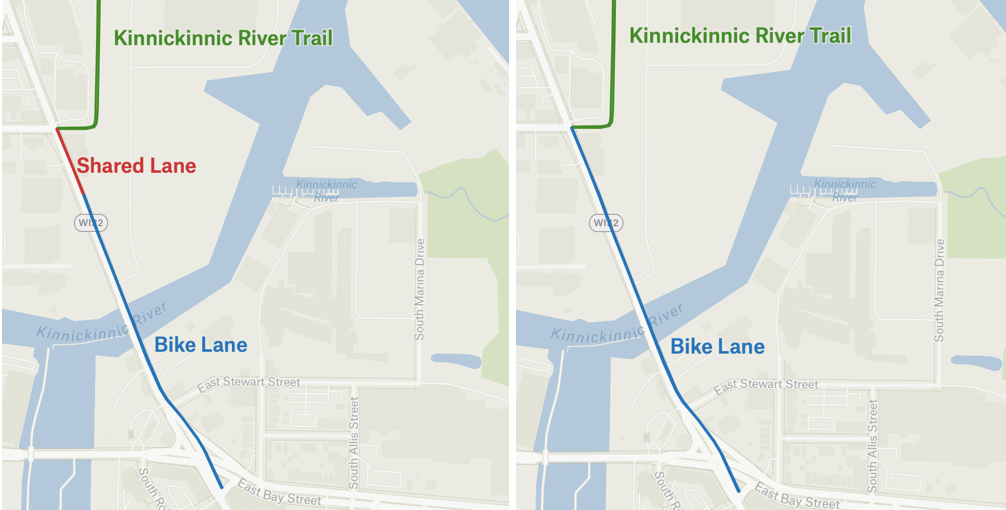
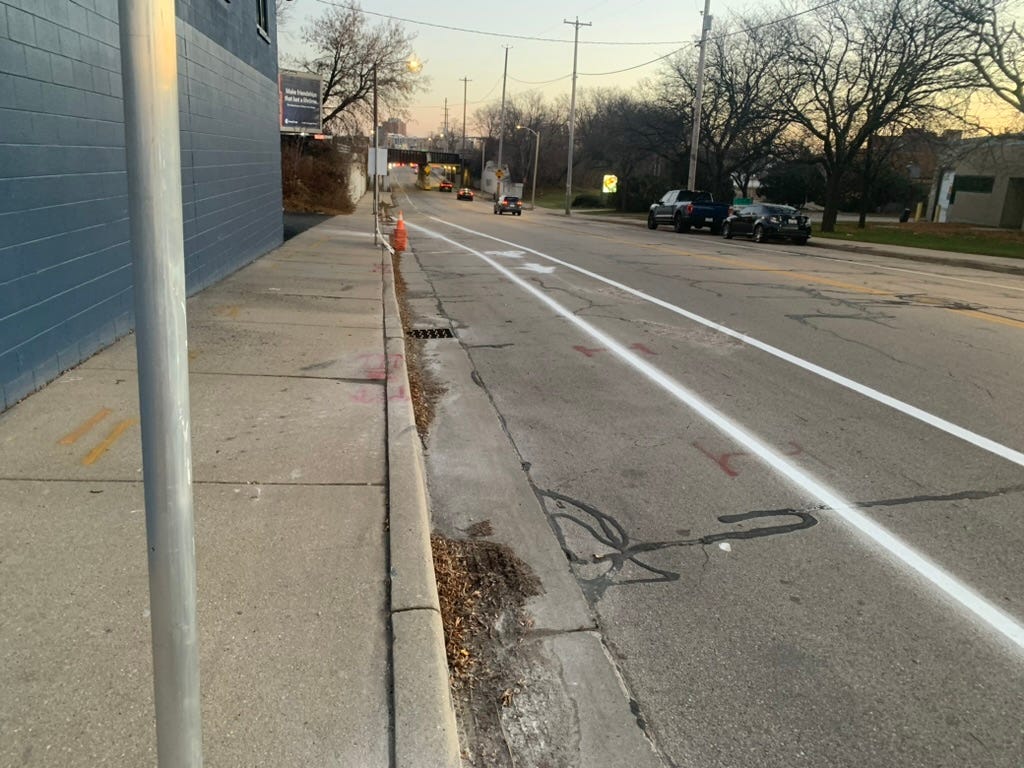
Over a decade after the trail was implemented as an unfortunate alternative to a bike path on the Hoan Bridge and four and a half years of repeatedly raising this significant gap in the network with elected officials and DPW, there is finally a continuous bike lane along KK from Bay View to the KKRT. Even if it’s not the ideal infrastructure, it’s an improvement to comfort and safety for cyclists to not have to merge with moving vehicle traffic while pedaling uphill. The visibility improvement for those exiting the trail is also significant. We are however frustrated that the City chose to preserve a few unnecessary door-zone parking spots.
Curious about a project? Check out Engage MKE
There are many road projects happening in Milwaukee. To learn more about them, check out Engage MKE. This resource is a good place to start for understanding the major projects occurring in Milwaukee. Projects include:
